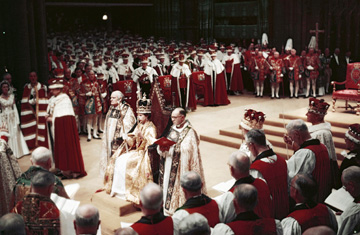
Crowning Glory The Queen at her coronation in June 1953
(2 of 3)
The Figurehead Is Not What She Seems
Though the Queen herself may seem ageless, there are aspects of palace life that positively creak. Honorary positions at court still include an official called the earl marshal, charged with arranging the sovereign's funeral and overseeing the coronation of the sovereign's successor. Watching 12 bagpipers process around the crystal-laden table at a state banquet or noticing that most of the British women attending have accessorized their evening gowns with sashes and family jewels reinforces the notion that Buckingham Palace is only that — a palace, a living museum. In fact it is the corporate headquarters of one of the world's best-known brands and one of the pillars of Britain's unwritten constitution. Look past the footmen and valets and flummery, and one finds an organization run at least as professionally as many multinationals.
As for the boss, she may have inherited her job, but she's a natural. The Queen "would make a good CEO," says one official. "Though she is interested in the details, she doesn't get into the weeds." Prime Minister David Cameron agrees: "A vital skill for a CEO is the ability to see the bigger picture, and she's certainly got that. I see her once a week to discuss the issues of the day, and I've noticed her knack for placing them in the broad sweep of events. Perhaps that's what 60 years in the job gives you."
By the time Elizabeth II ascended the throne, the empire her father had reigned over was shrinking, as former colonies cast off British rule, many opting for Commonwealth membership instead. The Queen, now head of the Commonwealth, handled the transition with the unblinking ease of someone schooled by childhood experience to appreciate the impermanence of even the most solid-looking edifices. (During World War II, German bombers scored seven direct hits on Buckingham Palace.) That sensibility has also enabled her to understand that while Britons consent to the monarchy now, they may not do so in future.
The turbulence of 1992 reinforced that point. Her two older sons' marriages failed, and Britons struggling through an economic downturn wondered why their taxes were subsidizing feckless royals. A fire at Windsor Castle set the seal on what she termed her "annus horribilis."
But, as she almost always does, the Queen rose to the challenge, continuing a process of upgrading the running of her household and the quality of her advisers and opening the royal finances to more scrutiny. She volunteered to pay income tax for the first time and backed a cost-cutting regimen that has enabled the budget for her household to remain static for the past two decades.
The Queen's goal is what palace insiders term "imperceptible change," modernizing without risking dilution of the royal brand. The changes in the way it communicates are stark. The Queen's Christmas message was first televised in 1957. ("That it is possible for some of you to see me today is just another example of the speed at which things are changing all around us," she said.) Since 2006 it has been podcast. After the launch of a royal YouTube channel in 2007, the British Empire 2.0 has gone on to colonize Facebook, Twitter and Flickr with royal pages and feeds. (More than half a million people Like the British Monarchy page on Facebook.) These were not decisions slipped past the Queen, but part of a communications strategy developed in close consultation with her.
The Queen has occasionally allowed documentary makers to film her but has never much enjoyed the results. Elizabeth R, shown in 1992, probably came closest to pleasing both the monarch and the television executives, with its carefully choreographed behind-the-scenes glimpses and some deadpan commentaries by its eponymous heroine.
The Royal Family, broadcast in 1969, the first TV documentary to portray the Windsors off duty, drew U.K. audiences of 23 million and a further 350 million worldwide. A fragment released for a Diamond Jubilee exhibition shows why the Queen may well have been right to withhold her permission for it to be broadcast again in its fascinating entirety. The Queen is seen making her family laugh by describing her own battle not to laugh at a formal occasion ("It is extremely difficult sometimes to keep a straight face," she says) and scrambling to make small talk with Richard Nixon, another public figure who would soon learn to regret the recording of private conversations. Decades later, the Queen's daughter Princess Anne dismissed the 1969 documentary as "a rotten idea. The attention that had been brought on one ever since one was a child, you just didn't want any more. The last thing you needed was greater access."
